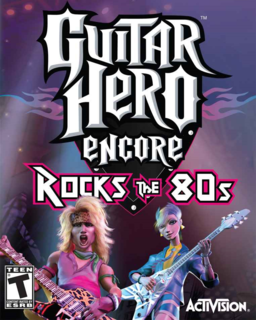Fans of Guitar Hero will enjoy having new songs to play, but anyone else might want to wait for the price to drop a bit.
Beyond the 30 new songs, and some minor cosmetic changes to the guitarists, venues, and menus, there is absolutely nothing new here. The game plays identically to Guitar Hero II in every single way. That's not really a bad thing; GH2 is one of the most addictive, fun, and challenging games to come along in a very, very long time. But, don't expect anything new to be thrown into the mix. In fact, much of Guitar Hero's ancillary content has been removed. Most of the guitarists are not present, only Judy Nails, Pandora, Johnny Napalm, Alex Steele, Izzy Sparks, and the Grip Ripper return, without any alternate costumes. Most, if not all, of the guitar models return, but in limited colors. There are no unlockable tracks, and the RedOctane Club and Stonehenge venues are nowhere to be found. The elements of GH2 that do return either get a new coat of neon paint, or aren't changed at all. The venues and guitarists have gotten an 80s makeover, like Izzy Spark's spandex and feathered hair, the dot matrix banner in the Battle of the Bands gymnasium, and the Grim Ripper's 3D glasses and Flava Flav clock necklace. Oddly, though, the supporting band is the same group of low-resolution polygons from GH2. That little oversight reveals how lazy Harmonix was with this "expansion."
As glaring as haphazard changes stand out, they ultimately mean nothing to the person playing the game. All that matters is the songs. First is the good news. This game is hard. Very, very hard. Expert-level players will not have much trouble clearing the setlist in one sitting, but they will have trouble mastering many of the tracks in this game. While the main riffs of most of the tracks tend to be repetitive and easy, there are unbelievably difficult solos sprinkled throughout. The high difficulty on Winger's "Seventeen" and Extreme's "Play With Me" will not be much of a surprise, as they're the last songs in the game, but Limozeen's "Because, It's Midnite" is going to surprise many cocky GH players the first time they try it. Like earlier Guitar Hero games, most of the tracks are covers, but the vast majority are well done.
However, when you look at the setlist as a whole, it just doesn't jive. Harmonix tried to please everyone by including songs from every major 80's genre. There's hair metal, including Poison's "Nothin' But A Good Time" , New Wave, including Flock of Seagull's "I Ran" , speed metal, including Anthrax's "Caught In a Mosh", and Pop/Rock, including The Romantics' "What I Like About You." They do a good job of hitting each sub-genre, but they stay true to form and pick some head-scratchers. Oingo Boingo is a great example of 80s new wave, but their song "Only A Lad" is a bit of a stretch to put in Guitar Hero. It feels like Harmonix was really scraping the bottom of the barrel when it came to some of their song selections. The Go-Go's "We Got The Beat" is a classic from the 80s, but it's also the easiest song ever put in Guitar Hero, and has around 30 seconds of dead space in the middle. The 80s were defined by bands like Van Halen, Bon Jovi, and Def Leppard, but those bands are nowhere to be found. With so many prominent groups missing, it makes the borderline song choices seem even more out-of-place.
The biggest mistake made is on the marketing side, however. This game costs $50 new. That's the same price as Guitar Hero 2, which has over twice the music, more guitarists, more venues, and more guitars. GH80s is, in spirit, an expansion. As such, it should not cost the same amount as a full fledged Guitar Hero title. The high price tag on the mediocre tracklist makes this game all but impossible to recommend to anyone other than fans of Guitar Hero that need new songs to tide them over until Guitar Hero III is released.

